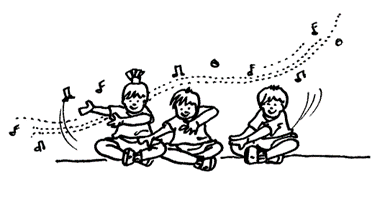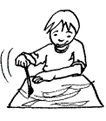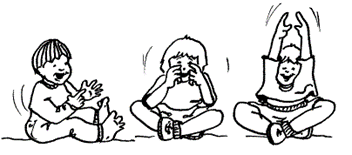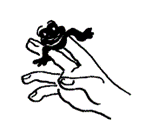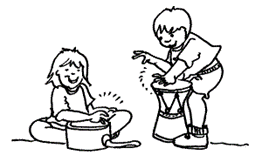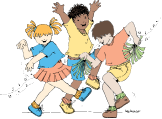Article 13 - Crossing the midline
|
What is meant by the term 'crossing the midline'? The body is divided into several planes or meridians and an important one for a child's successful movement and learning is called the 'Somital' or 'median' plane'. It runs vertically from the head down the middle of the body. This imaginary plane divides the body in half vertically.
A child initially experiences crossing the midline as a baby when they crawl. (See the information below titled CROSS PATTERNING and the article titled WHY CRAWLING IS IMPORTANT for more information on the importance of crawling). Crossing the midline and cross patterning actions and activities compliment each other and you cannot usually have one occurring without the other. As the child grows and moves through the developmental stages, they develop bilateral skills where they become aware of each side of their body and how that side can move and function. Before a child establishes the ability to cross the midline, he/she tends to use the hand closest to the object e.g. he/she tends to use the left hand to perform skills or reach for objects on the left side of the body and the right hand to the right side of the body. This is also common until hand dominance is established. 'Crossing the midline' is when the child then reaches with one hand, foot or leg to cross the imaginary midline to the other side body.
Throughout the child's play and education they experience many opportunities to naturally cross the midline e.g. as the child learns to use his/her dominant or preferred hand to perform a skill e.g. holding a crayon to draw, the non dominant hand supports the paper to keep it still. The movement of the drawing spontaneously crosses the midline to the other side of the paper to draw images there.
When a child spontaneously dances with a ribbon or scarf, their arms and ribbon 'cross the midline'. Their feet and legs may cross the midline through the movement as well.
When sitting with the legs crossed, the children are 'crossing the midline'. Sitting with both legs crossed also turns the hips and surrounding muscles into a correct position, which enables fluidity and co-ordination of the walking and running action. Some children sit in a W-Sit which is detrimental to this development occurring naturally. (See the detailed information on 'W SITTING' below)
When a child claps his/her hands together, they meet at the midline. There are many clapping activities throughout my Creative Capers Lesson Plans.
Action songs can involve crossing the midline with the arms, again depending on the song and actions required. There are many action songs throughout the Creative Capers Lesson Plans.
Painting and other art and craft activities involve spontaneous actions which involve the hand and arm 'crossing the midline'.
Finger play involving chants, poems and songs can involve the finger, hand, and arm or eyes 'crossing the midline'.
Finger puppets can enhance finger play activities. See the Section tilted ALL ABOUT PUPPETS for further information.
Playing drums is a wonderful way to use both hands (integrating the brain) and crossing over the midline.
Play in a sandpit or creative play throughout the day.
All types of dancing are such a valuable activity to enhance crossing the midline.
Why is crossing the midline so important? Being able to cross the midline is very important for a child's development. Not only is it essential for reading and writing at school, but it is required for getting dressed or putting socks and shoes, cleaning our teeth and other daily activities, participating in sport activities and during play.
When a child has difficulty crossing the midline, it can affect their efficiency and learning e.g. if a child is painting at an easel and reaches the middle of the paper, he/she may change hands to paint on the other side (right hand for right side of paper, left hand for left side of paper) The child may only draw or write on one side of the page, or place the paper or book to one side, or hold their body to one side to compensate. The child may also have problems tracking (eyes moving together) or following a moving object or the words across a page while reading.
Benefits of crossing the midline: ● assists in developing important brain pathways and connections ●assists in establishing awareness of both sides of the body ● assists in the child learning hand dominance ● prepares the child for reading and writing skills where the hand and eyes need to cross the midline to enable effective learning. ● enhances mobility of the body ● enhances core stability (strengthening of the centre of the body) ● enhances flexibility in the upper body joints and ligaments ● enhances hand-eye co-ordination (especially during activities such as ball activities, painting on an easel or finger play actions and songs) ● enhances spatial awareness ● assists with balance Crossing the mid line activities can be found throughout the Creative Capers Lesson Plans.
|

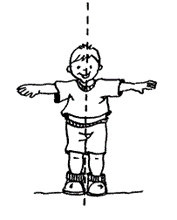
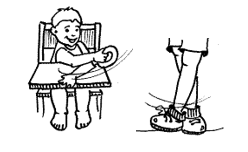
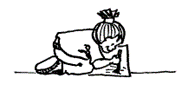
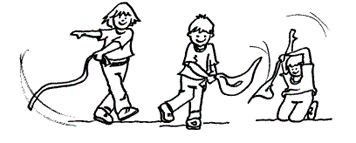
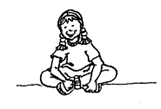
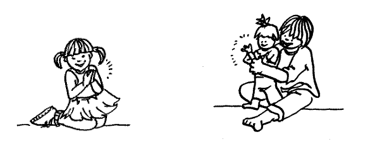
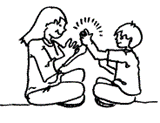 Clapping games performed with a partner can 'cross the midline', depending on the action. Clapping activities are available throughout the Creative Capers Lesson Plans (See the lesson titled 'Hands and Feet').
Clapping games performed with a partner can 'cross the midline', depending on the action. Clapping activities are available throughout the Creative Capers Lesson Plans (See the lesson titled 'Hands and Feet').